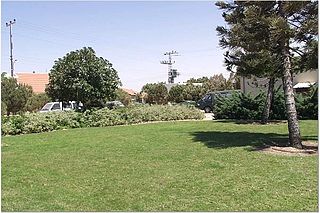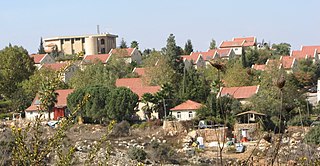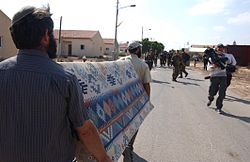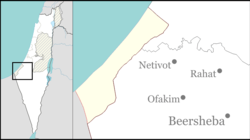
In 2005, 21 Israeli settlements in the Gaza Strip and four Israeli settlements in the West Bank were unilaterally dismantled. Israeli settlers and army evacuated from inside the Gaza Strip, redeploying its military along the border. The disengagement was conducted unilaterally by Israel; in particular, Israel rejected any coordination or orderly hand-over to the Palestinian Authority. Despite the disengagement, the Gaza Strip is still considered to be occupied under international law.

Gush Katif was a bloc of 17 Israeli settlements in the southern Gaza Strip. In August 2005, the Israel Defense Forces removed the 8,600 Israeli residents from their homes after a decision from the Cabinet of Israel. The communities were demolished as part of Israel's unilateral disengagement from Gaza.
Ganei Tal was an Israeli settlement in the south of the Gaza Strip, located in the Gush Katif settlement bloc. It was under the jurisdiction of Hof Aza Regional Council.

Netzarim was an Israeli settlement in the Gaza Strip about 5 kilometers southwest of Gaza City. It was established in 1972. In August 2005, the inhabitants of Netzarim were evicted by the Israel Defense Forces (IDF) as part of Israel's unilateral disengagement plan.

Morag was an Israeli settlement organized as a moshav in the Gush Katif settlement bloc. in the south-west edge of the Gaza Strip. It was evacuated as part of Israel's unilateral disengagement plan of 2005.

Bnei Atzmon was an Israeli settlement previously in the Sinai Peninsula, later moved to the Gaza Strip before being destroyed in 2005.
Gadid was an Israeli settlement and Moshav located in the middle of the Gush Katif settlement bloc whose residents were expelled in Israel's disengagement of 2005. The origin of the name Gadid comes from the term used in the bible to describe the harvest of dates in the area.

Ofra is an Israeli settlement located in the northern Israeli-occupied West Bank. Located on the main road between Jerusalem and Nablus, it falls under the jurisdiction of Mateh Binyamin Regional Council. In 2022 it had a population of 3,497.
Slav was an Israeli settlement in the Gush Katif settlement bloc, located in the south-west edge of the Gaza Strip until 2005.
Tel Katifa, was a small Israeli settlement located in the northeast end of the Gush Katif settlement bloc of the Gaza Strip, and evacuated in Israel's disengagement of 2005.
Nisanit was the largest Israeli settlement in the northern tip of the Gaza Strip in a mini-settlement bloc including Elei Sinai and Dugit. While Nisanit was under the municipal authority of the Hof Aza Regional Council it was not physically in the Gush Katif bloc where the bulk of the 'Gush Katif' settlements were located.

Elei Sinai was an Israeli settlement in the north of the Gaza Strip.
Shirat HaYam was an Israeli settlement established in 2001 on the shores of the Mediterranean Sea west of Neve Dekalim in the Gush Katif settlement bloc in the Gaza Strip until 2005.

Homesh was an Israeli settlement in the West Bank along Route 60, just south of the Palestinian towns of Silat ad-Dhahr and Fandaqumiya, illegally built over private Palestinian land. The settlement was under the administrative jurisdiction of the Shomron Regional Council. In 2005, the settlement homes were demolished along with three other settlements in the northern West Bank, at the same time as the Israeli disengagement from Gaza.

Kadim was an Israeli settlement on a hilltop in the northern West Bank, just west of the large Palestinian city of Jenin, under the administrative jurisdiction of Shomron Regional Council.

Sa-Nur was an Israeli settlement in the northern West Bank, just north of the Palestinian towns of Silat ad-Dhahr and Fandaqumiya, under the administrative jurisdiction of Shomron Regional Council until 2005. Prior to its demolition, Sa-Nur was home to 43 families.

Yavne'el is a moshava and local council in the Northern District of Israel. Founded in 1901, it is one of the oldest rural Jewish communities in the country. According to the Israel Central Bureau of Statistics (CBS), in 2022 it had a population of 4,542. In 2008 the population had been 3,100, with a growth rate of 1.4%.

Caravan is an Israeli term referring to a portable building used as a living space, school classroom, synagogue, or community center.

The Sheikh Jarrah controversy, which has been described as a "property/real estate dispute" by the Israeli government and its supporters, and as an "expulsion", "displacement" or "ethnic cleansing" event and a matter of international law by Palestinians and their supporters, is a long-running legal and political dispute between Palestinians and Israelis over the ownership of certain properties and housing units in Sheikh Jarrah, East Jerusalem. The evictions are considered a contributory cause of the 2021 Israel–Palestine crisis.














